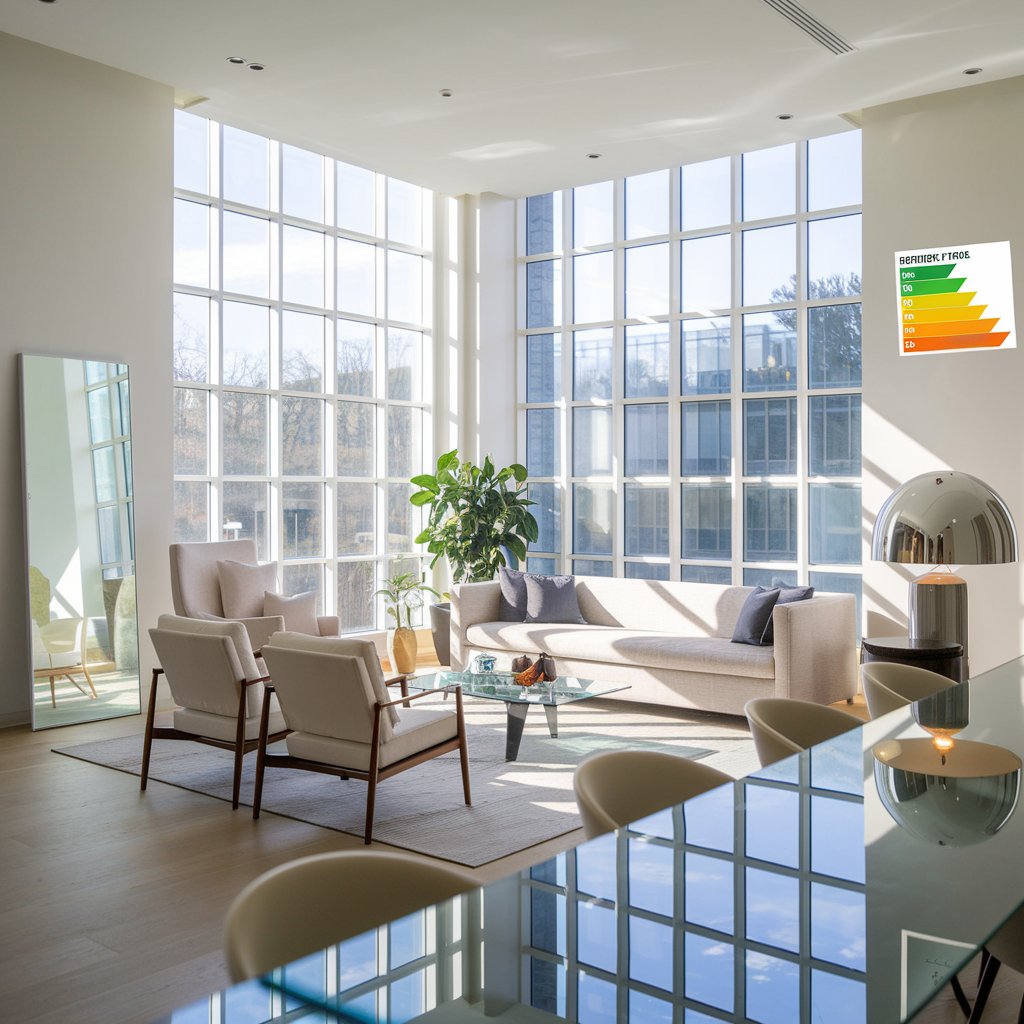MISHub QI
Natural Lighting and Energy Savings in Interior Design Projects
Natural Lighting and Energy Savings in Interior Design Projects
Introduction
Natural lighting is one of the most important elements in interior design, influencing not only visual comfort and aesthetics, but also contributing to the energy efficiency of buildings. The intelligent use of natural light can significantly reduce electricity consumption, reducing costs and environmental impacts. This study addresses strategies for using natural light and its implications in architectural projects.
Benefits of Natural Lighting [1]
- Energy Efficiency [2] , [3]
-
- Reduction in the use of artificial light during the day, reducing energy demand.
- Complementing LED lighting systems to create hybrid environments.
-
Visual and Psychological Comfort [4]
- Improvement in the quality of lighting in indoor spaces.
- Connection with the external environment, providing well-being and productivity.
-
Contribution to Sustainability [5]
- Reducing carbon emissions by decreasing dependence on non-renewable energy sources.
Architectural Elements to Maximize Natural Light [6] , [7] , [8]
-
Windows and Openings
- Selection of glass materials with high light transmittance.
- Strategic design to prevent overheating and glare.
-
Skylights
- Ideal for buildings with central spaces without direct access to windows.
- They allow uniform lighting in larger areas.
-
Glass Walls and Brise-Soleil
- Integration of laminated or tempered glass to allow light to enter.
- Use of sunshades to control direct sunlight.
-
Colors and Finishes
- Light colored internal surfaces to maximize light reflection.
- Materials that reduce heat absorption and optimize luminosity.
Planning Spaces with Natural Light [9] , [10]
-
Solar Orientation
- Design windows and openings based on the sun's path.
- Living areas facing south (in the northern hemisphere) for greater enjoyment.
-
Internal Zoning
- Distribute spaces that need more light (such as offices or living rooms) in areas with greater exposure to natural light.
- Use of translucent partitions to share light between environments.
-
Control of Excessive Light
- Installation of blinds, curtains or photochromic panels.
- Automated systems that adjust light input according to solar intensity.
Technologies Associated with Natural Lighting [6] , [11]
-
Smart Glass
- Electrochromic glass that adjusts transparency according to light intensity.
- Insulating glass to minimize thermal losses.
-
Solar Light Tubes
- They transport natural light to internal areas without direct access to windows.
- Highly efficient in very deep buildings.
-
Automated Lighting Systems
- Sensors that adjust artificial light based on the amount of natural light available.
Solar Orientation in Different Hemispheres: South or North Facing Living Areas [12]
Solar orientation is one of the main factors to consider when taking advantage of natural light in interior design and buildings. The way the sun shines throughout the day and year varies depending on the hemisphere in which the building is located.
Northern Hemisphere: South-Facing Living Areas
In the Northern Hemisphere, the Sun travels across the sky, moving mainly in the south. This means that:
- South facing: Receives a greater amount of direct sunlight throughout the day, especially during winter when the sun is lower on the horizon.
-
Practical Application:
- Living areas, rooms and offices: These areas are designed to face south as they need more natural light and heat.
- Energy Efficiency: This approach reduces the need for heating in winter and improves natural lighting, saving energy.
- Solar Control in Summer: During the summer, the sun is higher, allowing the use of sunshades, eaves or awnings to prevent overheating.
Southern Hemisphere: North-Facing Living Areas
In the southern hemisphere, the solar behavior is opposite: the sun moves north. This implies that:
- North Face: It is the sunniest and ideal for taking advantage of sunlight throughout the day.
-
Practical Application:
- Living areas and most frequented areas: They are designed to face north, benefiting from direct sunlight, especially in winter.
- Solar Control in Summer: As in the northern hemisphere, it is essential to use shading devices to avoid excess heat in the hottest months.
Other Guidelines and Considerations
East and West:
-
- The east side receives morning sun, ideal for bedrooms or spaces that require soft light early in the day.
- The west side receives late afternoon light, so greater solar control is needed to avoid overheating, especially in hot climates.
South Face in the Southern Hemisphere and North Face in the Northern Hemisphere:
-
- These sides receive less direct sunlight throughout the year, making them ideal for areas with less use or spaces that require milder temperatures, such as storage rooms or garages.
Mozambique is located in the southern hemisphere , with much of the country lying below the equator. This means that in Mozambique, to make the most of natural light and solar heat, it is ideal to design living areas facing north .
This orientation allows buildings to receive more direct sunlight throughout the day, especially during the winter months when the sun is more inclined to the north. In addition, shading devices such as eaves or awnings can be used to prevent overheating during the summer.
In the case of bedrooms, especially those intended for rest and which do not need intense sunlight throughout the day, the orientation can be adjusted to capture the sun in the early hours of the morning . In Mozambique, located in the southern hemisphere, this means positioning the bedrooms facing east , where the sun rises.
Advantages of East-Facing Rooms:
- Soft light in the morning : Morning sunlight is less intense and more comfortable, ideal for rooms that need pleasant natural lighting in the early hours of the day.
- Cooler temperature : Direct sunlight will not be present during the afternoon, when temperatures tend to be higher, keeping rooms cooler.
- Nighttime comfort : The absence of direct sunlight throughout the day reduces heat build-up, making rooms more comfortable at night.
Other Function-Based Guidelines:
- Work or study areas : They can be oriented towards the east or north , ensuring good natural lighting in the morning or throughout the day, without excessive shadows.
- Kitchens : Can be positioned to the south or west , where sunlight will be more intense in the afternoon, but excessive heat can be limited with smaller windows or sun protection.
- Living rooms : To make the most of natural light throughout the day, they should face north in the southern hemisphere.
Additional Considerations:
- Protection against overheating : Regardless of the orientation, using shading elements, such as eaves, trees, sunshades or thermal curtains, helps to control the heat and intensity of sunlight.
- Cross ventilation : In addition to solar orientation, it is crucial to ensure air circulation for thermal comfort, especially in tropical climates such as Mozambique. (This paragraph is better covered in the topic " Ventilation Systems and Thermal Comfort for Tropical Buildings ")
When designing, the combination of good natural lighting and ventilation is essential to ensure energy efficiency, comfort and functionality of spaces.
Advantages and Disadvantages of Natural Lighting
| Advantages | Disadvantages |
|---|---|
| Saving electricity | May cause glare or overheating |
| Improved health and well-being | High initial implementation costs |
| Reducing carbon emissions | Need for maintenance of glass and sunshades |
Conclusion
Natural lighting is an essential resource for sustainable and energy-efficient interior design. Its integration requires careful planning, which considers not only the use of light, but also the potential challenges related to heat control and light intensity. Combined with modern technologies and good architectural practices, natural light is a practical, economical and sustainable solution for any type of building.
Bibliographic references
[1] Reinhart, C. F., & Selkowitz, S. (2017). Daylighting Handbook I: Fundamentals, Designing with the Sun. Harvard Graduate School of Design.
[2] Pérez-Lombard, L., Ortiz, J., & Pout, C. (2008). A review on buildings energy consumption information. Energy and Buildings , 40(3), 394-398.
[3] Li, D.H., & Tsang, E.K. (2008). An analysis of daylighting performance for office buildings in Hong Kong. Building and Environment , 43(3), 413-423.
[4] Veitch, JA, & Galasiu, AD (2012). The physiological and psychological effects of daylighting. Lighting Research & Technology , 44(1), 37-75.
[5] United Nations Environment Program (UNEP). (2016). Sustainable Building and Construction Initiative: Promoting Policies and Practices for Sustainability .
[6] Tregenza, P., & Wilson, M. (2011). Daylighting: Architecture and Lighting Design . Routledge.
[7] Lechner, N. (2014). Heating, Cooling, Lighting: Sustainable Design Methods for Architects . Wiley.
[8] Moore, F. (2013). Environmental Control Systems: Heating, Cooling, Lighting . McGraw-Hill Education.
[9] Konya, A. (2013). Design Primer for Hot Climates . Architectural Press.
[10] Brown, G. Z., & DeKay, M. (2014). Sun, Wind, and Light: Architectural Design Strategies . Wiley.
[11] Baetens, R., Jelle, B. P., & Gustavsen, A. (2010). Properties, requirements, and possibilities of smart windows for dynamic daylight and solar energy control in buildings: A state-of-the-art review. Solar Energy Materials and Solar Cells , 94(2), 87-105.
[12] Givoni, B. (1998). Climate Considerations in Building and Urban Design . Wiley.
Authors: Eng. Francisco Quisele Jr .; Architect Ângelo Luís
Date of publication : 11/26/24
Share


